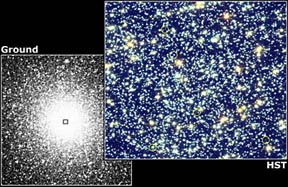This image of a blue straggler, a rejuvenated star that glows with the light of younger stars, was taken by he Hubble Space Telescope's Wide Field and Planetary Camera 2 in October of 1997.
Click on image for full size
NASA
Blue Stars Cheer-up Astronomers
News story originally written on November 3, 1997
Astronomers have used the Hubble Space Telescope (HST) to find evidence of
how a unique type of star called a blue straggler is formed. "This is an
extremely exciting result," astronomer Rex Saffer said, "because it may
help distinguish between competing theories of blue straggler star
formation and evolution."
Blue stragglers are stars, located in
globular clusters, which are about
twice as massive yet one-fifth as young as their neighboring stars. This
is unusual because most stars in a cluster are thought to have formed
around the same time and in a similar manner. Allan Sandage first
discovered this different type of star nearly 45 years ago.
For years astronomers have wondered how these stars form. The two main
theories are based on blue stragglers forming from two separate stars.
One theory states that the two stars were in a binary system and they
eventually merged. The other theory states that the two stars happened
to collide in the star-filled globular clusters. Analysis of the
information from the HST leads scientists to believe the slower theory,
based on a binary system.
You might also be interested in:

It was another exciting and frustrating year for the space science program. It seemed that every step forward led to one backwards. Either way, NASA led the way to a great century of discovery. Unfortunately,
...more
The Space Shuttle Discovery lifted off from Kennedy Space Center at 2:19 p.m. EST, October 29th. The sky was clear and the weather was great as Discovery took 8 1/2 minutes to reach orbit for the Unitied
...more
A moon was discovered orbiting the asteroid, Eugenia. This is only the second time in history that a satellite has been seen circling an asteroid. A special mirror allowed scientists to find the moon
...more
Will Russia ever put the service module for the International Space Station in space? NASA officials are demanding an answer from the Russian government. The necessary service module is currently waiting
...more
During a period of about two days in early May, 1998, the ACE spacecraft was immersed in plasma associated with a coronal mass ejection (CME). The SWICS instrument on ACE, which determines unambiguously
...more
J.S. Maini of the Canadian Forest Service has referred to forests as the "heart and lungs of the world." Forests reduce soil erosion, maintain water quality, contribute to atmospheric humidity and cloud
...more
In late April through mid-May 2002, all five naked-eye planets are visible simultaneously in the night sky! This is includes Mercury which is generally very hard to see because of its proximity to the
...more















